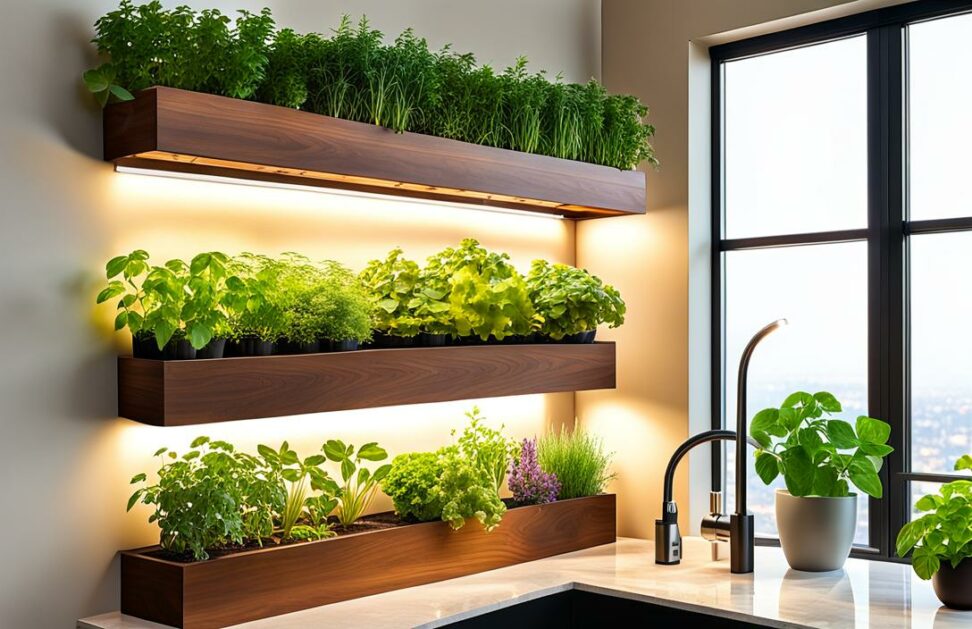Grow a Flavorful Indoor Herb Garden With This Simple Lighting Trick
For cooks who love using fresh herbs to elevate their dishes, growing an indoor herb garden can provide a convenient and consistent source of flavorful garnishes. However, many urban dwellers struggle to get enough natural sunlight to successfully grow herbs indoors. Fortunately, with a simple lighting setup, you can ensure your indoor herb garden thrives and provides an abundant harvest.
Supplementing sunlight with dedicated grow lights gives indoor herb gardens the radiant energy they need. When paired with the right containers and care techniques, home grow lights allow you to cultivate robust herbs like basil, oregano, and rosemary right in your own kitchen.

Why Start an Indoor Herb Garden?
Culinary herbs are a quick and effortless way to add fresh flavor to meals. An indoor herb garden lets you enjoy fresh-picked herbs year round. Choosing the right herbs, containers, and grow lights can help you craft a productive and low-maintenance indoor garden. Here are some of the benefits of growing herbs at home:
- Access to fresh herbs whenever you're cooking - no more wilted store-bought herbs!
- Ability to grow heat-loving herbs regardless of your climate
- Convenience of picking herbs steps away from your kitchen
- Decorative and aromatic element for your home
Best Herbs for Indoor Cultivation
Herbs that thrive with minimal maintenance make the best choices for indoor gardening. These herbs tend to grow well indoors:
- Basil - grows rapidly and likes warm conditions
- Mint - extremely hardy and tolerates partial shade
- Parsley - handles pots well and regrows when harvested
- Thyme - aromatic leaves even in low light
- Oregano - thrives indoors with good drainage
- Rosemary - appreciates the warm temperatures inside
- Sage - compact variety suitable for containers
Keys to Growing Indoor Herb Gardens
Herbs grown indoors have slightly different needs than outdoor gardens. Here are some tips for cultivating thriving indoor herbs:
- Lots of sunlight from a sunny window or grow lights
- High-quality potting mix in containers with drainage holes
- Regular watering once the soil partly dries out
- Occasional fertilizing to provide nutrients
- Frequent harvesting encourages new growth
Overcoming Light Challenges for Indoor Herbs
Lack of adequate sunlight often hinders indoor herb gardens. Window-sill herb gardens rely on whatever ambient sunlight they can capture. But most homes simply don't get enough strong, direct sunlight for herbs to really flourish. The solution? Provide supplemental lighting with grow lights!
Choosing Grow Lights for Indoor Herb Gardens
From fluorescent tubes to high-tech LEDs, many types of electric grow lights can stimulate plant growth indoors. Consider your space and budget when selecting lights.
Fluorescent Grow Lights
- One of the most affordable options for indoor gardeners.
- Come in long tubes that are typically mounted in light fixtures.
- Provide a balance of light from the color spectrum.
LED Grow Lights
- Extremely energy-efficient and long-lasting.
- Full spectrum LEDs emit light like the sun for robust plants.
- Adjustable panels allow custom positioning.
High Intensity Discharge (HID) Lights
- Most powerful type of horticultural lighting.
- Includes metal halide and high-pressure sodium bulbs.
- Best for larger indoor gardens with more plants.
Setting Up Your Grow Lights
Proper placement of grow lights is key to maximizing their effectiveness. Follow these tips when installing lights for your indoor herb garden:
- Determine the amount of space you need to illuminate for current and future plants.
- Select grow lights suited for that coverage area.
- Use adjustable chains to hang lights at the ideal height.
- Keep lights 6-12 inches above the top leaves of plants.
- Run lights for 12-16 hours per day.
Getting Your Indoor Herb Garden Started
Once you understand how to provide ample lighting, it's time to put together the rest of your indoor herb garden setup. Follow these steps when establishing your first indoor herb garden.
Picking Indoor Herb Garden Containers
You have lots of options when it comes to picking herb garden planters and pots. Consider your space constraints, desired aesthetics, and plant needs.
- Self-watering pots - require less maintenance
- Window boxes - maximize sill space
- Hanging baskets - work well for trailing herbs
- Vertical gardens - great use of wall space
Preparing the Growing Medium
Herbs thrive in a high-quality potting soil amended with extras for drainage. Aim for a mix like this:
- 60-70% sterile potting soil - provides nutrients
- 30% perlite - improves drainage and aeration
Sowing Herb Seeds or Transplanting Seedlings
You can start herbs from seed or opt for transplants from the garden center. Follow best practices when planting:
- Follow seed packet or plant tag instructions
- Bury seeds at proper depth in moistened soil
- Carefully separate root-bound seedlings
- Label pots clearly so you remember what's planted
Caring for Your Thriving Indoor Herb Garden
Once planted, indoor herbs need minimal care. Follow these tips:
- Water when top inch of soil dries out
- Trim and harvest herbs frequently to encourage growth
- Watch for pests like aphids or fungus gnats
- Clean leaves and repot when root-bound
Your indoor herb garden will provide you with homegrown flavor all year long! Snip fresh herbs to add to:
- Meals - add to pastas, salads, eggs, meat, and more
- Oils and vinegars - infuse your own flavored oils
- Herb butters - blend with softened butter
- Salts and sugars - make your own seasoned salts
With the right combination of containers, soil, and grow lights, you can cultivate an indoor herb garden anywhere. Supplement natural light with an easy grow light system and enjoy picking fresh herbs in your own kitchen!